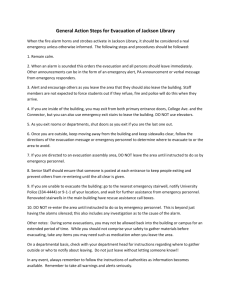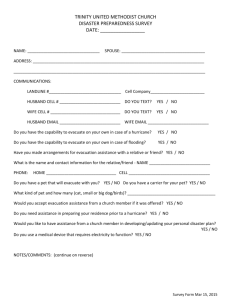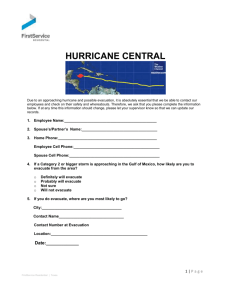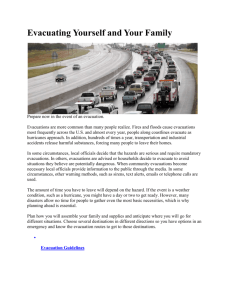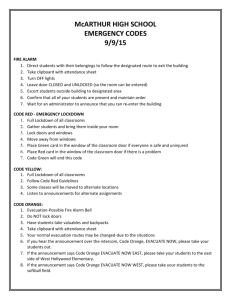Assisting Persons with Disabilities
advertisement
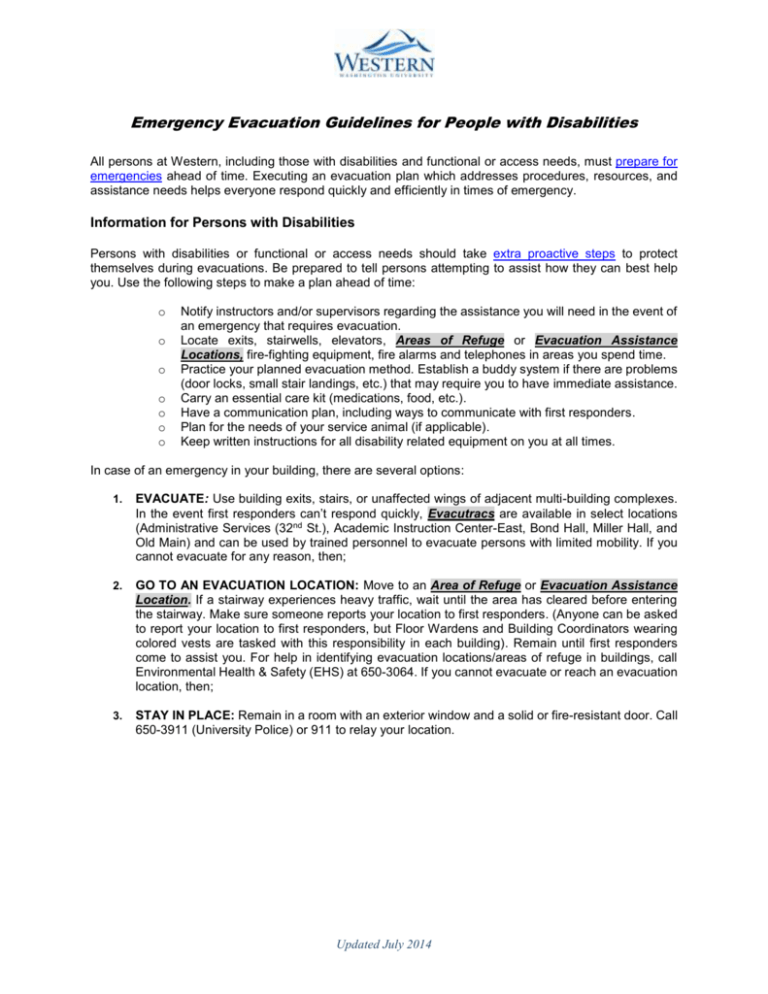
Emergency Evacuation Guidelines for People with Disabilities All persons at Western, including those with disabilities and functional or access needs, must prepare for emergencies ahead of time. Executing an evacuation plan which addresses procedures, resources, and assistance needs helps everyone respond quickly and efficiently in times of emergency. Information for Persons with Disabilities Persons with disabilities or functional or access needs should take extra proactive steps to protect themselves during evacuations. Be prepared to tell persons attempting to assist how they can best help you. Use the following steps to make a plan ahead of time: o o o o o o o Notify instructors and/or supervisors regarding the assistance you will need in the event of an emergency that requires evacuation. Locate exits, stairwells, elevators, Areas of Refuge or Evacuation Assistance Locations, fire-fighting equipment, fire alarms and telephones in areas you spend time. Practice your planned evacuation method. Establish a buddy system if there are problems (door locks, small stair landings, etc.) that may require you to have immediate assistance. Carry an essential care kit (medications, food, etc.). Have a communication plan, including ways to communicate with first responders. Plan for the needs of your service animal (if applicable). Keep written instructions for all disability related equipment on you at all times. In case of an emergency in your building, there are several options: 1. EVACUATE: Use building exits, stairs, or unaffected wings of adjacent multi-building complexes. In the event first responders can’t respond quickly, Evacutracs are available in select locations (Administrative Services (32nd St.), Academic Instruction Center-East, Bond Hall, Miller Hall, and Old Main) and can be used by trained personnel to evacuate persons with limited mobility. If you cannot evacuate for any reason, then; 2. GO TO AN EVACUATION LOCATION: Move to an Area of Refuge or Evacuation Assistance Location. If a stairway experiences heavy traffic, wait until the area has cleared before entering the stairway. Make sure someone reports your location to first responders. (Anyone can be asked to report your location to first responders, but Floor Wardens and Building Coordinators wearing colored vests are tasked with this responsibility in each building). Remain until first responders come to assist you. For help in identifying evacuation locations/areas of refuge in buildings, call Environmental Health & Safety (EHS) at 650-3064. If you cannot evacuate or reach an evacuation location, then; 3. STAY IN PLACE: Remain in a room with an exterior window and a solid or fire-resistant door. Call 650-3911 (University Police) or 911 to relay your location. Updated July 2014 Assisting Persons with Disabilities Faculty/Staff Responsibilities Faculty and staff should take a few moments at the beginning of the first class each quarter to advise the class of evacuation procedures, nearest exits, building assembly locations, and Emergency Response Guide locations in each classroom. For additional information, reference Western’s Emergency Response Guide’s Faculty Information for Classroom. Western’s Emergency Preparedness video is available at EHS website and can be shown in class. Always ask someone with a disability or functional or access needs how you can help before giving assistance. Ask how he/she can best be assisted or moved, and whether there are any special considerations or items that need to come with the person. If you are unable to physically assist, inform a Floor Warden, Building Coordinator, or first responder of the person’s location. Considerations Mobility-- Wheelchair Persons using wheelchairs should move to an Area of Refuge or Evacuation Assistance Location. Wheelchair users are advised to wait until the heavy traffic has passed before entering the stairway. Evacutracs may be used when first responders are unavailable to assist. Stairway evacuation of wheelchair users should be conducted by trained personnel. If it is unsafe to evacuate the wheelchair user, move them to the stairwell and immediately notify Building Coordinators or first responders once outside the building. Mobility -- Non-Wheelchair Persons with limited mobility may be able to negotiate stairs in an emergency with assistance. If danger is imminent, the individual should go to an enclosed stairwell and wait until the heavy traffic has cleared before attempting the stairs. Evacutracs may be used when first responders are unavailable to assist. Stairway evacuation should be conducted by trained personnel. If it is not safe to evacuate the person with limited mobility, move them to an Area of Refuge or Evacuation Assistance Location and immediately notify Building Coordinators or first responders once outside the building. Hearing Most buildings on campus are equipped with fire alarm strobe lights. Persons with hearing disabilities may not hear audio emergency alarms and will need to be alerted of emergency situations in those buildings without strobe lights. Emergency instructions should be given by gesturing or writing a short explicit note. Escort the person as needed. Visual Most people with a visual disability should be familiar with their immediate surroundings and frequently traveled routes. Since the emergency evacuation route is likely different from the commonly traveled route, persons with visual disabilities may need assistance in evacuating. The assistant should offer their elbow to the individual with a visual impairment and guide him or her through the evacuation route. Communicate as necessary to assure safe evacuation. Speech People with a speech disability can hear standard alarms and voice announcements, and they can see visual indicators that warn of danger and the need to evacuate. Therefore, no special accommodation or additional planning is needed for people with speech disabilities. Cognitive People with a cognitive disability can hear standard alarms and see visual indicators to evacuate. However, the ability to recognize, understand, and respond appropriately to fire alarms and other emergency notification systems should be evaluated. Provide appropriate assistance or guidance as necessary. Additional Resources For questions or to request this information in alternative formats, contact disAbility Resources for Students, the Equal Opportunity Office, Environmental Health and Safety, or Human Resources. Additional emergency information is available in Western’s Emergency Response Guide, located in offices and classrooms. Updated July 2014


